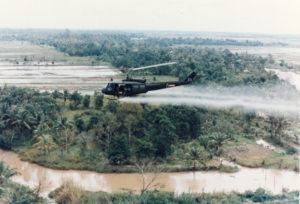
U.S. Army Huey helicopter spraying Agent Orange over agricultural land during the Vietnam War in its herbicidal warfare campaign. Wikipedia photo
WASHINGTON — Last month, VA began processing disability claims for asthma, rhinitis and sinusitis on a presumptive basis for veterans who served in southwest Asia and some other areas.
The presumption is based on their likely exposure to burn pits and other toxic environmental factors. The conditions must have manifested within 10 years of the time the veteran was serving in an environmentally toxic area.
The move is considered a victory by legislators and veterans’ advocates, who have been arguing for years that toxic exposure during wartime is far more widespread and impactful to a servicemember’s health than previously realized. Now, legislation being debated in Congress could add far more presumptive conditions, making it possible for millions of veterans to be newly eligible for VA benefits.
While there are many opportunities for servicemembers to be exposed to toxic substances during their service, open-air burn pits are some of the most dangerous and have become the center of the toxic exposure debate.
Throughout the first Gulf War and the post-9/11 conflicts in Iraq and Afghanistan, the military regularly used burn pits to dispose of waste. Everything from human and medical waste, electronics, plastic and various chemicals were dumped into the pit, doused in jet fuel and lit on fire. The resulting plumes of smoke were massive and could be seen for miles.
The fight by veterans’ advocates to recognize the harm caused by these burn pits, as well as other environmental hazards, has been compared to the struggle by Vietnam veterans to have VA recognize the presumptive conditions linked to Agent Orange.
According to VA, their decision to add the three presumptive conditions is based on an ongoing internal review of the existing science, most notably the series of reports released by the National Academies of Sciences, Engineering, and Medicine (NAS). A September NAS 2020 report looking at 27 respiratory illnesses found limited or suggested evidence linking persistent cough, shortness of breath and wheezing to toxic exposure for veterans who served in Iraq and Afghanistan, as well as the 1990-1991 Persian Gulf War.
VA’s new rule encompasses veterans who served throughout the entire southwest Asia theater of operations, which includes Iraq, Kuwait, Saudi Arabia and a number of other countries, from Aug. 2, 1990, to the present, as well as veterans who served in Afghanistan, Syria or Djibouti from Sept. 19, 2001, to the present.
“I announced my intent to initiate rule making on May 27 to consider adding respiratory conditions to the list of chronic disabilities,” explained VA Secretary Denis McDonough in a statement. “Through this process, I determined that the evidence provided was sufficient to establish presumptions of service connection for these three respiratory conditions. This is the right decision, and VA will continue to use a holistic approach in determining toxic exposure presumptives moving forward.”
Because the internal scientific review is ongoing, VA has left open the possibility that it will independently add more conditions to the presumptive list. But Congress might preempt them.
The COST of War Act in the Senate includes 13 new presumptive conditions. The Honoring Our PACT Act in the House includes 23 new presumptive conditions. Both bills include the three conditions VA has already added. The biggest difference between the two pieces of legislation as far as presumptive conditions is how they approach cancer. While the House bill would make head, neck, respiratory, gastrointestinal, reproductive, kidney, brain, melanoma, pancreatic, lymphoma and lymphomatic cancers of any type a presumptive condition, the Senate bill is limited to respiratory cancers.
It’s been estimated that as many as 3.5 million veterans could receive new care and benefits under the bills.
